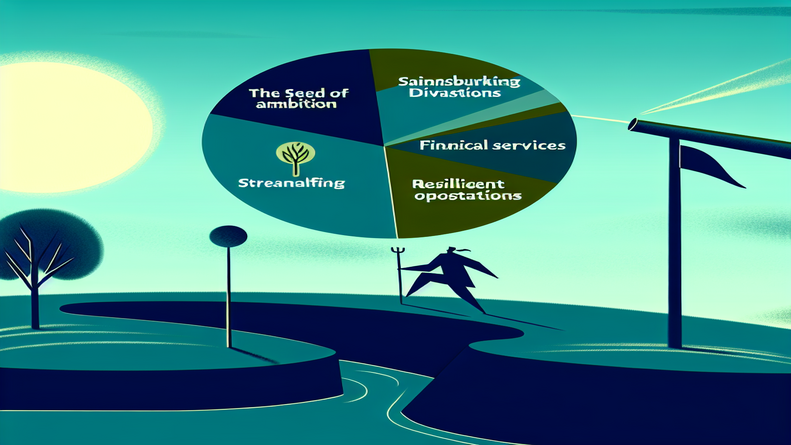Imagine living in a world where retail banking is much more than a mere financial service; it’s an integral part of a shopping experience, offering convenience and rewards. The world has witnessed such innovations, with Sainsbury’s, a UK retail giant, stepping into the realm of finance, integrating shopping with banking. But as the news hits that Sainsbury’s is to wind down its banking division, after offloading its mortgage book to Co-operative Bank, we are reminded of the volatility and ever-changing dynamics of the industry. This blog post delves into the rise and fall of Sainsbury’s banking venture, exploring the lessons learned and future possibilities for integrating retail with financial services.
The Seed of Ambition: Sainsbury’s Leap into Financial Services
When Sainsbury’s first ventured into the financial sector, there was a palpable excitement about the potential for a retail behemoth to reshape personal banking. The company aimed to leverage its vast network of loyal customers by offering competitive banking products aligned with their shopping habits. Their ambition was to create a seamless ecosystem where clients could manage their money where they shopped, earning rewards and benefits in the process. However, the initial exuberance was met with the complexities inherent to the banking industry. Regulatory challenges, the demand for financial expertise, and the need to establish trust beyond the retail domain were significant hurdles. The integration of two distinct customer service cultures also proved to be a considerable undertaking.
The Pivot Point: Challenges Met with Innovation
The banking landscape is dynamic, and even giants like Sainsbury’s were not impervious to its tremors. As the market evolved, with fintech startups and online banks gaining ground, Sainsbury’s banking division hustled to maintain its relevance. They sought to innovate and diversify their offerings, but challenges such as increasing competition from dedicated financial institutions started to undermine their strategy. The pivot was necessary but difficult. The company had to balance its investment in banking with the core retail business’s demands, always considering the potential returns and the implications for their consumer base.
Streamlining Operations: Focusing on Core Strengths
 In a strategic maneuver, Sainsbury’s decided to streamline its operations, which eventually led to the divestment of its mortgage book to Co-operative Bank. This was a clear indication of the company refocusing on its retail roots while acknowledging that banking required a level of specialization that they could no longer sustain alongside their primary business. The decision to wind down the banking division, while impactful, was a testament to the company’s adaptive approach. It underscored the importance of recognizing core strengths and the courage to withdraw from ventures that no longer align with the overarching business objectives.
In a strategic maneuver, Sainsbury’s decided to streamline its operations, which eventually led to the divestment of its mortgage book to Co-operative Bank. This was a clear indication of the company refocusing on its retail roots while acknowledging that banking required a level of specialization that they could no longer sustain alongside their primary business. The decision to wind down the banking division, while impactful, was a testament to the company’s adaptive approach. It underscored the importance of recognizing core strengths and the courage to withdraw from ventures that no longer align with the overarching business objectives.
Looking Ahead: The Future without Sainsbury’s Banking
As Sainsbury’s banking operations come to a close, questions arise regarding the future of retail banking and how other retail companies might approach this space. This event also highlights the need for traditional retailers to innovate responsibly, recognizing when a strategic partnership with specialized financial entities could be more beneficial than in-house operations. The closure also opens up opportunities for the bank’s customers and competition. With the right movement, other banks can capture the market share left behind, while customers might benefit from improved services and products catered to their needs.
Resilient Adaptation: The Key to Future Ventures
The narrative of Sainsbury’s banking division tells a story of ambition, adaptation, and resilience. For retail conglomerates eyeing the financial services arena, the lessons are invaluable. It demonstrates the importance of adaptability and the need to continually assess market fit and return on investment. As the retail landscape continues to evolve with the integration of technology and changing consumer behavior, other players can draw inspiration from Sainsbury’s journey, recognizing the potential for success and the wisdom to pivot when needed.
In Conclusion: The Sainsbury’s Banking Lesson
To conclude, the closure of Sainsbury’s banking division marks the end of an era and raises intriguing considerations about the relationship between retail and banking. It reflects upon the ever-present need for innovation balanced with a prudent evaluation of one’s capabilities and market conditions. The story of Sainsbury’s Bank will remain a pivotal case study in the retail-banking narrative, offering insights and inspiration for future retail giants aiming to expand their horizons.Are you ready to join the movement and redefine the scope of what’s possible within your organization? Connect with me on [laurent Rochetta’s LinkedIn page](https://www.linkedin.com/in/laurentrochetta/) to explore how you can harness the power of technology and embark on a journey of unparalleled progress.
🚀🌟
